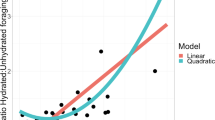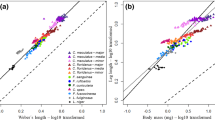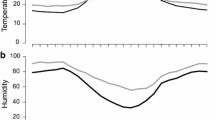Summary
Ocymyrmex barbiger is a diurnal scavenger of arthropods in which the number of successful foraging excursions per colony per day increases with daily vapour pressure deficit. It appears that the ants make use of prey items which succumb to thermal and desiccation stress. Running speed is a function of surface temperature but progressively less time is spent searching for prey beyond a critical surface temperature with the result that the optimal search temperature for individual foragers is about 52°C. Maximal foraging activity of colonies occurs at surface temperatures corresponding to this optimal search temperature.
Zusammenfassung
Bei derOcymyrmex barbiger, einem aasfressenden, tagaktiven Gliederfuessler, nehmen die erfolgreichen Nahrungsexkursionen, innerhalb einer Kolonie und eines Tages, mit dem taeglichen Dampfdruckabfall zu. Es hat den Anschein, als wuerden die Ameisen bei der Beutesuche von den Tieren Gebrauch machen, die den Temperaturen und der Austrocknung erlegen sind. Die schnelle Fortbewegung ist von der Oberflaechentemperatur abhaengig und sobald ein Grenzwert der Oberflaechentemperatur ueberschritten ist, wird zunehmend weniger Zeit fuer die Nahrungssuche aufgebracht. Die optimale Temperatur fuer die Nahrungssuche der einzelnen Ameise liegt bei ungefahr 52°C. Die maximale Aktivitat der nahrungssuchenden Ameisen einer Kolonie tritt bei Oberflaechen temperaturen ein, die dieser optimalen Temperatur entsprechen.
Similar content being viewed by others
References
Bursell E., 1964. — Environmental aspects: Temperature. In: M Rockstein (ed),The physiology of insecta. Vol. 1 Academic Press, New York and London, 284–321.
Dreisig H., 1980. — Daily activity, thermoregulation and water loss in the Tiger BeetleCicindela hybrida.Oecologia, 44, 376–389.
Edney E.B., 1977. — Water balance in land arthropods.Springer-Verlag, Berlin, Heidelberg and New York.
Harkness R., Wehner R., 1977. —Cataglyphis.Endeavour, 1, 115–121.
Krebs J.R., McCleery R.H., 1984. — Optimization in behavioural ecology. In: J.R. Krebs & N.B. Davies (eds), Behavioural ecology.An evolutionary approach. Blackwell Scientific Publications, London, pp. 91–121.
Marsh A.C., in press. — Thermal responses and temperature tolerance in a diurnal desert ant,Ocymyrmex barbiger. Physiol. Zool., 58.
Morton S.R., 1982. — Granivory in the Australian arid zone: diversity of harvester ants and structure of their communities. In:W.R. Barker &P.J.M. Greenslade (eds),Evolution of the flora and fauna of arid Australia. Peacock Publications, Frewville, pp. 257–262.
Oster G.F., Wilson E.O., 1978. — Caste and ecology in the social insects.Princeton University Press, Princeton.
Porter S.D., Jorgensen C.D., 1981. — Foragers of the harvester ant,Pogonomyrmex owyheei: A disposable caste?Behav. Ecol. Sociobiol., 9, 247–256.
Prins A.J., 1963. — A list of the ants collected in the Kruger National Park with notes on their distribution.Koedoe, 6, 91–108.
Prins A.J., 1965. — African Formicidae (Hymenoptera). Description of a new species.S. Afr. J. Agric. Sci., 8, 1021–1024.
Schmid-Hempel P., 1983. — Foraging ecology and colony structure of two sympatric species of desert antsCataglyphis bicolor andCataglyphis albicans. Ph. D.thesis, University of Zurich.
Schoener T.W., 1971. — Theory of foraging strategies.Ann. Rev. Ecol. Syst., 11, 369–404.
Wehner R., Harkness R.D., Schmid-Hempel P., 1983. — Foraging strategies in individually searching ants,Cataglyphis bicolor (Hymenoptera: Formicidae).Akademie der Wissenschaften und der literatur, Math.-Naturwiss. K1, Stuttgart.
Whitford W.G., 1978. — Foraging by seed-harvesting ants. In:M.V. Brian (ed),Production ecology of ants and termites. Cambridge University Press, pp. 107–110.
Whitford W.G., Depree E., Johnson P., 1980. — Foraging ecology of two Chihuahuan desert and species:Novomessor cockerelli andNovomessor albisetosus.Insect. Soc., 27, 148–156.
Wilson E.O., 1971. —The insect societies. Belknap Press, Harvard, Massachusetts and London.
Author information
Authors and Affiliations
Rights and permissions
About this article
Cite this article
Marsh, A.C. Microclimatic factors influencing foraging patterns and success of the thermophilic desert ant,Ocymyrmex barbiger . Ins. Soc 32, 286–296 (1985). https://doi.org/10.1007/BF02224917
Received:
Published:
Issue Date:
DOI: https://doi.org/10.1007/BF02224917




